|
|
|
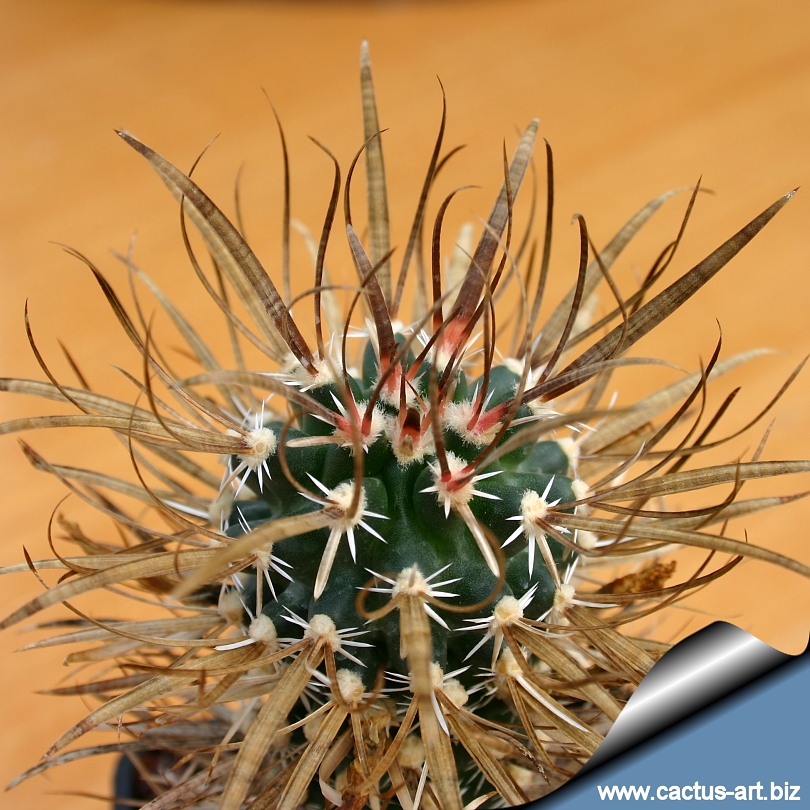
Toumeya papyracantha
SB330 Sandoval County, New Mexico,
This
population has very long
flat
papery spines.
The
centrals
are brown with the new
growth of a
bright red colour, the
radials
are short and pure white.
|
|
Habit:
Solitary, or slowly branching.
Stem:
Dark green, 2.5-20 cm tall and 1-2 cm in diameter. It has no ribs
and tubercles are
elongate.
Stem anatomy: The
stele is particularly thin, usually 2 mm or
less in diameter, without
medullary
vascular system. Large
mucilage cells occur in the tubercles and in the
cortex, but are
not present in the
pith.
Tissues which have
mucilage cells are
conspicuously slimy when freshly cut.
Areoles : 0.1-0.15 cm in diameter at the summits of the
tubercles, and generally 0.3 cm apart.
Glands,
which are
homologous with spines, are frequently on the
adaxial sides of areoles which do not produce flowers
Spines:
Central spines usually 1-2 (occasionally 3-4), strongly
flattened, flexible, grooved, twisted,
papery in texture, 1.8-3.8 long. often obscuring the surface
of the stem.
Radial spines parallel to the stem surface, 6-8 per
cluster, ashy-white, 3.0 mm long.
Flower: On the new growth of the current
season near the apex of the stem. Whitish,
bell-shaped, with a
brownish central
midstripe, 1.8-2.5 cm wide.
Fruit:
Green, often changing to tan, spherical, 1.2-2.0 cm long,
dry and
dehiscent at
maturity along a
dorsal slit and around the
circumscissile
apex.
Seeds: Black, covered with minute bumps, irregularly oval in shape,
slightly flattened, and 2.5 mm long.
Phenology: Blooming
time:
April/May
Roots:
Fibrous 5-10 cm long
Notes: There
are no recognized
subspecies,
varieties, or
forms.
|
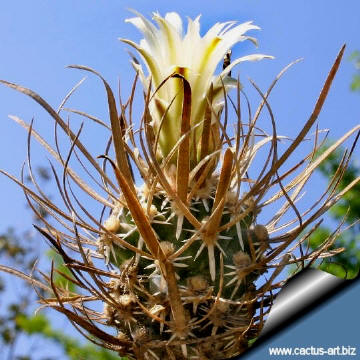 |
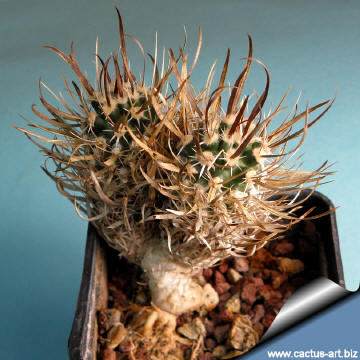 |
|
. |
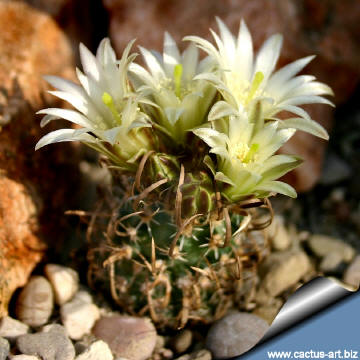
The flowers are whitish to pale yellowish appear on |
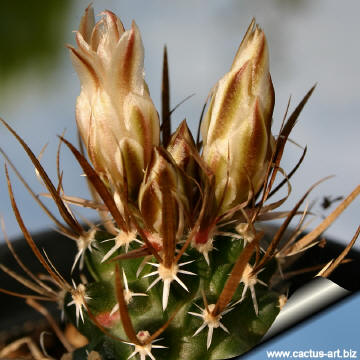
the new growth of the current season near the apex.
|
|
. |
|
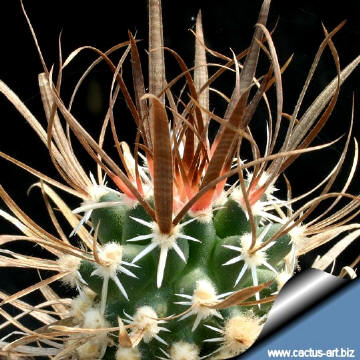
New spines in spring |
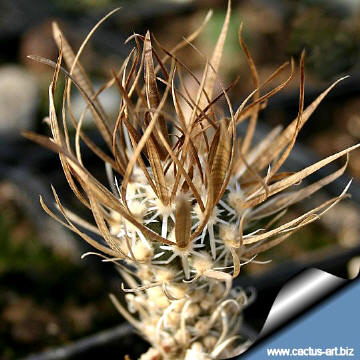
A plant in winter. |
|
. |
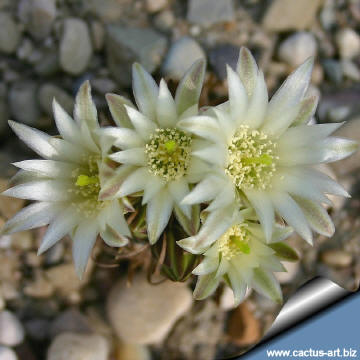 |
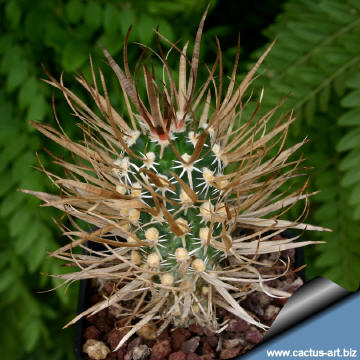 |
|
Photo of conspecific taxa, varieties, forms and cultivars of Toumeya
papyracantha:
Advertising
|
|
|
|
Family:
Cactaceae (Cactus
Family)
Scientific Name:
Toumeya
papyracantha
Type:
"In a valley between the lower hills near Santa Fe in loose sandy red
soil.
Type
specimen:
HT: MO. Fendler, 15 May 1847
Basionym:
Mammillaria
papyracantha Engelmann, Mem.
Amer. Acad. II, 4:49, 1849.
Distribution: USA, Arizona (Southern portion
of Navajo County, Apache County)
New Mexico (southeast Rio Arriba
County and McKinley County to
Grant and Dona Ana counties) Texas (Hudspeth County) Colorado and
Mexico. T. papyracantha is
inconspicuous and probably irregular in occurrence; it may be
more widespread than presently known.
Conservation status: Listed in
CITES
Appendix I
Quite abundant, at least in parts of range (6-20
occurrences
globally reported), but now sharply reduced due to degradation of
habitats,
collection and development. It is imperilled and vulnerable to
extinction, But its highly
inconspicuous nature makes it a difficult species to locate and
study.
Vernacular
name (s):
Grama-grass cactus,
Paper-spined cactus,
Paperspine fishhook cactus,
Toumeya
Synonyms:
- Pediocactus papyracanthus (Engelm.)
L.D. Benson,
Published in:
Cact. and Succ. Jour. 34(2): 61. 1962.
- Mammillaria papyracantha
Engelm.
Published in: Mem. Amer.
Acad. Arts, n.s. 4: 49. 1849.
- Sclerocactus papyracanthus (Engelm.)
N.P. Taylor
- Toumeya papyracanthus Britton
and Rose
- Echinocactus papyracanthus
Engelm,
Etymology:
The
genus
name "Toumeya" commemorates Dean James W.
Toumey (New Mexico) who was also honoured by Britton & Rose,
whose work benefited from Toumey’s fieldwork and
collections of cactus
specimens.
The
species name
"papyracantha" derives from
the greek word
“papyrus (παπυρος)”
that means
" papyrus (Cyperus papyrus); paper "
and from “acantha (ακανϑα)”
that means “thorn, spine"
(The specific name implies:
“papery spines”)
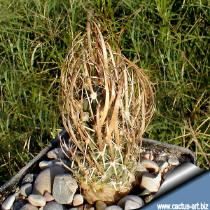 Habitat: Grows in open flats in pinyon-juniper
woodlands, great Plains
grassland, and Chihuahuan
Desert grassland. At an
elevation of 1500 - 2300 m. Restricted to fine,
sandy
clay loams and red sandy soils; rarely
gypseous; often on highly erodable sites. Habitat: Grows in open flats in pinyon-juniper
woodlands, great Plains
grassland, and Chihuahuan
Desert grassland. At an
elevation of 1500 - 2300 m. Restricted to fine,
sandy
clay loams and red sandy soils; rarely
gypseous; often on highly erodable sites.
It is almost always found
associated in or near tufts or fairy rings of blue grama grass (Bouteloua
gracilis) where it is seldom seen thanks to its excellent
camouflage because the
papery spines resemble dried
grass
leaves. T. papyracantha demonstrate the
importance of
microclimate variation for cactus
growth,
in fact this plant depends upon the favourable microclimate provided
by grama grass to survive. Stems usually shrink during
dry
seasons, leaving only the
papery spines visible above ground.
|
|
|
|
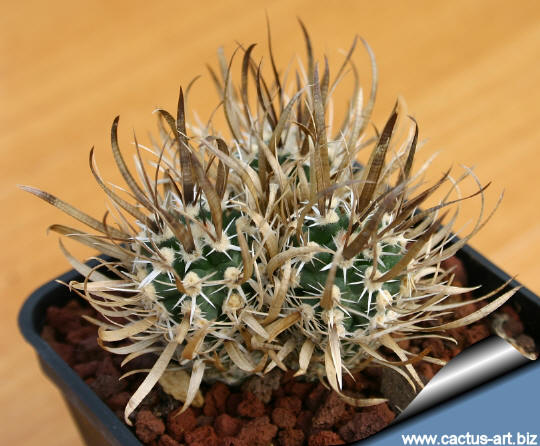
Toumeya papyracantha Locality: Snowflake, Arizona 1700 m.
The plant from Snowflake have shorter pale brown spines, bent upwards
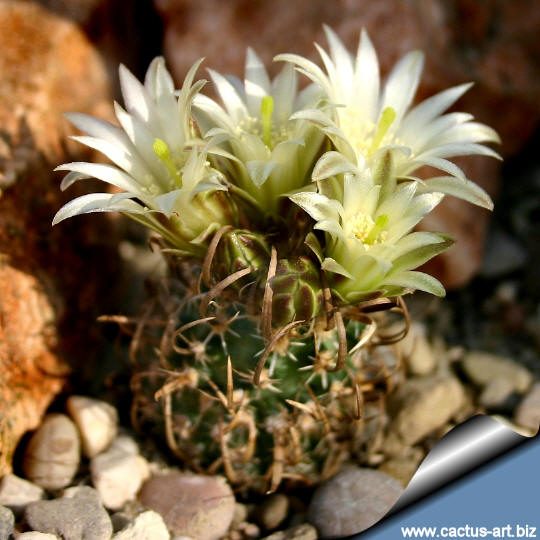
Cultivation:
Needs
moderate watering, because excess of water causes mature
individuals to rot and die, especially after transplanting.
Sun Exposure: Full sun to partial shade.
Cultural Practices: Needs a very
draining and
mineral
substratum.
Frost Tolerance: Very
frost hardy, above approx -12° C.
Propagation: Seeds:
Temperature for optimum
germination: night minimum approx 17 day maximum,
up to nearly 40
C, at any time of year with proper temperatures and
daylength (ca.13-14 hours); it is possible to extend
day-length with
artificial lights. Anyway the seeds
germinate slowly with extreme difficulty and a low rate of
success.
scarification and
stratification help, alternately
freeze
and
thaw both wet and dry, but don’t keep wet, alternate wet and
dry with changing temperatures. Germination can take several
years, so keep pot and try again next year. Seedlings do not do
well either, and some die each year, for this reason
plants are commonly
grafted on hardy stocks like
Opuntia compressa.
In this case
they are easy to grow and no special skill is required.

 |
|